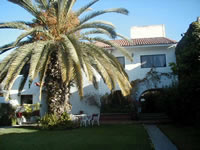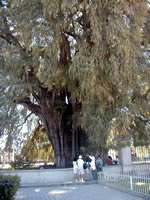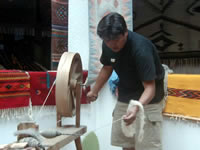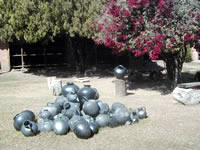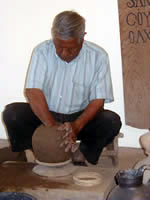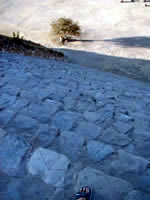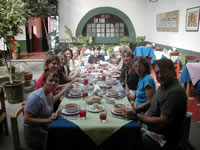HOME |
LOGBOOK |
| Volume
91 At last, we made it to Oaxaca, the prime objective of the inland trip I made with Jan Loomis in February of 2003. The bus ride through the mountains was gorgeous: high dry hillsides, lots of curves and climbs, hints of houses carving out an existence from a generally unrelenting-looking environment. The ride in made the fact of Oaxaca City even more amazing. The bus followed a hillside above the long broad valley where the city, as cities are wont to do, has sprawled outward. The phenomenon of around a half million people was startling. You just can’t expect it. The Oaxaca bus station was not new and modern like the others on our trip. Crouched around a pay phone with traffic roaring by, we made our calls to hotels and B&Bs, finding, to our dismay, most of our first choices full. But serendipity was once again on our side, and a referral sent to us to the Casa de Maria.
The Case de Maria was a pretty fair hike from the zocalo (center of town) – about 22 blocks, but the daily walk made us appreciate more than we might have otherwise the surprisingly lush greenery and gardens of this city in so high and dry mountains. No sooner than we dropped off our backpacks that first night, than we walked in to town on the hunt for orientation and supper. What a beautiful time of day! The light, low and warm, seemed to glow from the facades of the buildings, and supper we enjoyed at a sidewalk café around the zocalo. (Insert: scan of Oaxaca Zocalo postcard that I think I sent you in the enveleope) (Note: Food was a major element of our stay in Oaxaca, and most of that has been written up separately in the “From the Galley #18.”) Oaxaca has so much to offer the tourist. In season, the days are pleasantly warm and sunny, with nights just cool enough for a blanket. There are handsome buildings downtown (in particular the striking Iglesia de Santo Domingo with its agave-studded plaza), archeological ruins in the valley, and a bountiful and diverse collection of aretesanías (handicrafts) to be found either conveniently collected in stores in town or to be sought out at their sources in outlying villages. There was so much to do and see, that I knew we would not begin to be able to do it all.
Our second stop was at Teotitlán del Valle, a village famous for its weaving. At a workshop there, we were presented with a well-done demonstration of the complete process involved in making the serapes (weavings & rugs) –that are just one of Oaxaca Valley’s traditional industries. The demonstration began with carding the wool (which is brought in from elsewhere) and spinning it into yarn, moved on to the making of natural dyes from such sources as flowers and insect larvae, and, finally concluded with the weaving. At a huge loom in the back, we were able to see a weaver at work on a complicated rug, his hands scooting without hesitation perhaps a dozen shuttles through the warps. After the demo, of course, there was lots of time to make purchases from the thousands of showroom offerings that ranged from coasters, to doormats, to runners to huge area rugs. These are the times when it is both a good and bad thing not to have a house somewhere.
By the time we got back to the city, breakfast had long since worn off, which motivated us to seek out El Naranjo, a restaurant highly recommended in all our guidebooks. Our excellent meal led to our participation in chef Iliana de la Vega’s wonderful cooking class that is documented in “From the Galley #18” and which was a highlight of our trip.
On our way out of San Bartolome de Coyotepec, we stopped in workshop for alebrije., These are imaginative (almost hallucinogenically so!) carved and painted wooden figurines of creatures ranging from kitty cats to dragons! This is a new “industry” for Oaxacans that has grown out of traditional toys made for children. I craved a dragon – way too fragile a fancy for a sailboat, but settled for a saucy cat and a flame colored scorpion (which I confess I bought thinking it was a lobster!)
Briefly, Monte Albán, which sits on a flattened plateau atop a mountain a few kilometers west of Oaxaca City, is thought to have been first occupied around 500BC by the Zapotecs. From then it appears that the city experienced several different phases of use and growth. What I saw is believed to date mostly from the phase known as “Monte Albán III”, from 300-700AD, when the city was at its peak with a population reaching a quarter of a million sprawling down the nearby hillsides. Elmer pointed out a steep hill to the north with another set of ruins that is just beginning to be excavated. It’s interesting that the ancients chose to live on the mountaintops keeping the valleys free for agriculture, completely opposite to modern-day Oaxaca. The ruins of Monte Albán have a parallel row of precisely oriented building framing a level plaza, an I-shaped ball court on one side, a number of tombs (one of which yielded the richest treasure to be found in the Americas which is on display in the Museo de las Culturas in Oaxaca.), plus several pyramids and platforms. Only one building is askew with the precise alignment of the others, a building that is though to have been an observatory because its angle lines it up perfectly with seasonal celestial movement. It has an aperture, Elmer explained, that lets the sun enter on the precise day when the rainy season begins, signally the correct time for planting! There are also carvings in the stone to suggest the earliest written calendar originated here! The other particularly fascinating building displays large (maybe 6’) flat stone tablets with carvings of human figures. Originally these were identified as danzantes or dancers, but most recently, according to Elmer, they are thought to represent some kind of medical record, since each image has something wrong with it!
In conclusion, let me say that Oaxaca really is a not-to-be-missed destination for anyone coming to Mexico. I have every intention of returning with Don to Oaxaca (and to Puebla)– probably next winter – before we sail away from Mexico.
|
|
home
| waypoints | logbook | reference shelf
|

